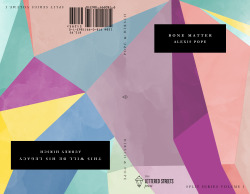Alexis Pope, Bone Matter and Aubrey Hirsch, This Will Be His Legacy
Alexis Pope, Bone Matter and Aubrey Hirsch, This Will Be His Legacy
Split Series Volume 1
The Lettered Streets Press, 2014
92 pp.
ISBN: 978-0-991863-1-0
Alexis Pope’s Bone Matter and Aubrey Hirsch’s This Will Be His Legacy form two halves of the first volume of Lettered Street Press’s Split Series. The press is a “collective of sorts” based out of Seattle and Chicago, and publishes poetry, fiction, nonfiction, and hybrid genres. The series is bound in a pastel modernist interpretation of an eighteenth-century marbled hardcover, with the chapbooks’ title and author printed on each side in a white all-caps serif font in a black box. The unassuming cover downplays the exquisite vibrancy of the stories and poems contained within. The variety of influences suggested by the poems and short shorts reveal the diversity of today’s publishing climate. Hirsch and Pope’s works, when read together, produce an energetic experience much like that of a well-planned open mic night.
 That’s not to say that the two chapbooks tackle similar territory, or even present their topics in a similar manner. Hirsch’s This Will Be His Legacy is a flash fiction collection of pseudohistorical biographies. She describes the characters’ lives as they appear off stage, focusing on events and possibilities that aren’t taught in high school history classes. The collection begins with “Amelia,” a romantic story that describes what really happened on Amelia Earhart’s fateful trip across the Atlantic in a Lockheed Electra with her navigator, Fred Noonan. As Amelia resists the names that society wants to call her, she “concentrates instead on her flying” and her eventual escape. Amelia’s alternative history provides a romantic twist on the pioneering feminist’s life. Other notable flash fictions in the collection include “The Nine Innings of Morrie Rath,” the story of the hitter struck by a ball when the World Series was rigged in 1919, recounted as if his entire life is a baseball game. Rath’s disappointment and inability to find closure with his life’s defining event appear like stages of grief and rage, and Hirsch handles his evolving emotions with clarity and compassion Although Rath’s tragedy seemingly has little to do with Amelia’s disappearance, both stories emphasize the complex afterlives of individuals who have been defined by a singular event.
That’s not to say that the two chapbooks tackle similar territory, or even present their topics in a similar manner. Hirsch’s This Will Be His Legacy is a flash fiction collection of pseudohistorical biographies. She describes the characters’ lives as they appear off stage, focusing on events and possibilities that aren’t taught in high school history classes. The collection begins with “Amelia,” a romantic story that describes what really happened on Amelia Earhart’s fateful trip across the Atlantic in a Lockheed Electra with her navigator, Fred Noonan. As Amelia resists the names that society wants to call her, she “concentrates instead on her flying” and her eventual escape. Amelia’s alternative history provides a romantic twist on the pioneering feminist’s life. Other notable flash fictions in the collection include “The Nine Innings of Morrie Rath,” the story of the hitter struck by a ball when the World Series was rigged in 1919, recounted as if his entire life is a baseball game. Rath’s disappointment and inability to find closure with his life’s defining event appear like stages of grief and rage, and Hirsch handles his evolving emotions with clarity and compassion Although Rath’s tragedy seemingly has little to do with Amelia’s disappearance, both stories emphasize the complex afterlives of individuals who have been defined by a singular event.
Though some of the stories are experimental, Hirsch also excels at narrative style. “Michael Collins” describes Collins’s experience as the only Apollo 11 astronaut not to land on the moon. As a lonely man traveling through space, he enjoys a sublime solitude that is every bit as transcendent as that of Neil Armstrong and Buzz Aldrin. Hirsch includes fictional characters as well, such as Rachel Garrett from the Star Trek universe, who time travels on the Enterprise without warning: “One moment, she’s seven years old eating pancakes with her mother, then she’s burying her first officer after a Klingon attack.” Garrett’s travels act as a metaphor for major events in her life and allow Hirsch to explore the deeper meanings of our experiences without sounding trite.
Pope’s poetry in Bone Matter takes a more personal approach. Recurring images such as seas, caves, and water tie the collection together, and while the chapbook does not follow a single narrative thread, many of the poems deal with the wreckage of broken hearts, waves, or structures. Bone Matter has plenty of violent moments, but the mental and physical effects of trauma blend together in a compelling and appealing way. The fragmented poem “Love Song for the After,” for example, describes the emotional aftereffects that happen when a baby is lost in utero. As the speaker tries to escape her feelings, she uses ambiguous phrases to signal the poem’s undefined agency: “I happen upon / a muscle spasm or does that / happen upon me?” The speaker in “Monologue for an Empty Bay” also suffers a breakdown after a relationship ends, but the poem wavers on whether she wants out before, during, or after her liaison ends. Frequently repeated words including “never,” “almost,” and “maybe” have the effect of negating or rejecting possibilities before they are even uttered and suggest that despite her soul-searching, the speaker herself doesn’t know the answer.
 Bone Matter as a whole seems like a tragic collection, but Pope writes her speakers with an awareness of their vulnerability as they seemingly blame themselves for things out of their control. The speakers have an unfulfilled need and, despite their aversion to trauma, are uncompromising as they try to heal their wounds. The last poem, “Between the End Scene & Your Mouth” provides the chapbook with moment of closure during a dramatic pause that clicks: “& there is no one here to tell me how wrong I am // When I say no one, I mean // her.” Pope uses italics sparingly, so the nameless “her” resonates with a power that reverberates through the previous poems. While “Between the End Scene & Your Mouth” ends with sadness, the poem gestures toward hope since the speaker at least discovers the source of her listless wanderings.
Bone Matter as a whole seems like a tragic collection, but Pope writes her speakers with an awareness of their vulnerability as they seemingly blame themselves for things out of their control. The speakers have an unfulfilled need and, despite their aversion to trauma, are uncompromising as they try to heal their wounds. The last poem, “Between the End Scene & Your Mouth” provides the chapbook with moment of closure during a dramatic pause that clicks: “& there is no one here to tell me how wrong I am // When I say no one, I mean // her.” Pope uses italics sparingly, so the nameless “her” resonates with a power that reverberates through the previous poems. While “Between the End Scene & Your Mouth” ends with sadness, the poem gestures toward hope since the speaker at least discovers the source of her listless wanderings.
After consuming This Will Be His Legacy and Bone Matter, I found it impossible to imagine reading one without the other. Both collections suggest that the stories told about us are not always what we would choose, but ones we can accept as part of our personal narrative. The Split Series proves that reading across genres enriches our understanding of both. Readers of both flash fiction and poetry will find much in this collection to satisfy their curiosity, and writers may be inspired to seek collaborators for their next chapbook. This impressive volume shows off the talents of its authors while introducing what has the potential to be a fascinating series. The second volume, featuring Melanie Sweeney and Jasmine Dreame Wagner is set to be released in late May, and promises to be just as shining as the first offering.

